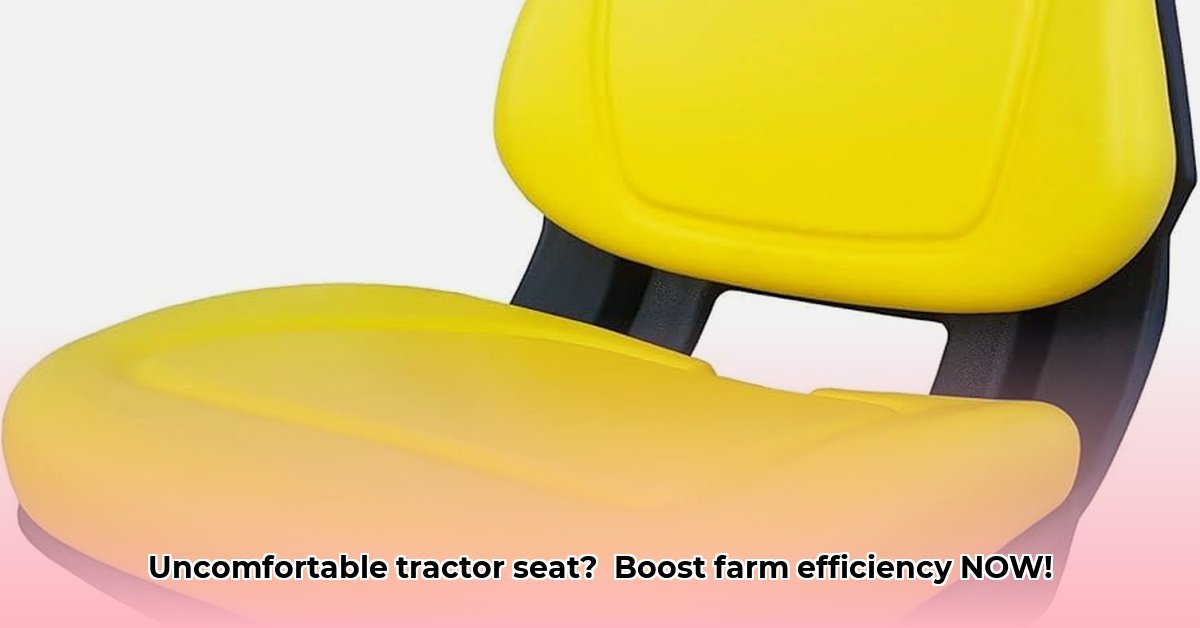
Want a more comfortable and efficient farming experience? Upgrading your John Deere tractor seat is a surprisingly effective way to achieve both. This guide will walk you through choosing the right replacement, installing it, and ensuring its longevity—all while highlighting the environmental and economic benefits of sustainable choices. Ready to boost your productivity and lessen your environmental footprint? Let's begin! For more seat options, check out this helpful resource: seat options.
Choosing the Right Replacement Seat: Prioritizing Sustainability and Performance
Replacing your tractor seat is more than just a comfort upgrade; it's a strategic investment. While various options exist, opting for an Original Equipment Manufacturer (OEM) part, like a John Deere TCA23663 (or its current equivalent for your model), offers several key advantages. OEM parts guarantee a perfect fit and seamless integration with your tractor's systems. This ensures optimal performance and minimizes the risk of compatibility issues. Furthermore, OEM seats often come with a warranty, protecting your investment.
Don't be swayed by cheaper, off-brand alternatives. While initial costs might be lower, the shorter lifespan of these seats often leads to more frequent replacements, ultimately increasing your long-term expenses. A quality OEM seat is a sustainable choice, extending the life of your equipment and reducing waste. Think of it as preventative maintenance for your body and your machinery. Isn't your comfort, and the longevity of your equipment, worth the investment?
Sustainability: A Comfortable Seat, A Productive Farmer, A Healthier Planet
Sustainable farming encompasses more than just crop rotation and soil health; it includes maximizing the efficiency and well-being of the farmer. An uncomfortable tractor seat leads to fatigue, backaches, and reduced focus, directly impacting your productivity and overall farm efficiency. By choosing a durable, high-quality seat – ideally an OEM part – you're extending the operational life of your tractor. This reduces the need for premature replacement, conserving resources and minimizing waste.
Moreover, a comfortable operator means a more productive operator. When you're not constantly shifting and readjusting due to discomfort, you can concentrate on your work, resulting in better yields and a healthier bottom line. By choosing sustainability, you're not just protecting the environment; you're bolstering your farm's long-term economic health. It's a win-win for both your well-being and the planet's.
Replacing Your John Deere Tractor Seat: A Simplified Guide
While detailed, illustrated instructions are best found in your John Deere owner's manual, this simplified overview provides a general outline:
Preparation: Always consult your owner's manual and prioritize safety. Gather your tools (wrenches, screwdrivers, etc.) and disconnect the negative battery terminal before starting electrical work.
Removal: Carefully remove the old seat, taking photos if needed to remember the assembly. Note the position of all bolts, nuts, and wiring connections.
Installation: Securely attach the new seat, ensuring everything is correctly aligned and fastened. Double-check all connections, particularly any wiring.
Testing: Reconnect the battery and thoroughly test the seat's functionality, ensuring all adjustments work smoothly.
Remember: If you're unsure about any step, consult a qualified mechanic. Safety is paramount.
Long-Term Considerations: Maintaining Your Investment and Promoting Sustainability
Regular maintenance is crucial for extending the lifespan of your tractor and maximizing its efficiency. This includes routine checks of fluid levels, lubrication of moving parts, and addressing minor issues before they escalate into major problems. This practice not only saves money in the long run but also contributes significantly to sustainable farming practices by reducing waste and resource consumption. Proper care of your equipment is a wise financial decision with far-reaching environmental benefits. Just as you'd maintain other farm equipment, consistent upkeep of the tractor seat is an integral part of sustainable farming.
OEM vs. Aftermarket Seats: A Comparative Look
Choosing between an OEM and aftermarket seat involves weighing several factors:
| Feature | OEM Replacement (e.g., John Deere TCA23663) | Aftermarket Replacement |
|---|---|---|
| Fit & Function | Guaranteed perfect fit; optimal performance | Potential fit issues; may affect functionality |
| Warranty | Full manufacturer warranty | Limited or no warranty |
| Durability | Typically longer lifespan | Varies; potentially shorter lifespan |
| Cost | Higher initial cost | Lower initial cost |
| Sustainability | Contributes to longer equipment lifespan; less waste | May lead to more waste and earlier equipment replacement |
Investing in a quality John Deere tractor seat replacement isn't just about comfort; it's a strategic decision that positively impacts your farm's efficiency, sustainability, and overall profitability. By prioritizing high-quality, durable parts and practicing regular maintenance, you ensure the longevity of your equipment and contribute to a more sustainable farming operation.